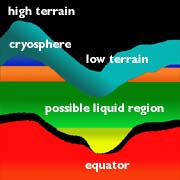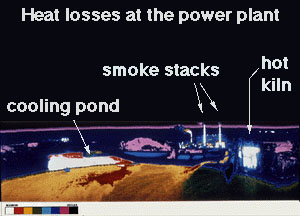Exploratour - Water on Mars
Mars Cryosphere
The figure shows a cross-section of the crust, and the unusual altitude variation of the Martian surface. The Martian geography is one of high altitudes at high latitudes and low altitudes at low latitudes. The figure illustrates the depth of frozen ground at various latitudes, called the cryosphere, as well as the depth to which the aquifer, or layer of liquid water, may exist across the planet.
The ground is less frozen at low latitudes because it is warmer and water can evaporate. Thus, at low latitudes (near the equator) the ground is possibly devoid of water to a depth of 200 m, while at high latitudes (corresponding to high altitudes) the ground is devoid of water to a depth of only 1 m. Another way of saying the same thing is that the frozen ground may be only 2.5 km deep at the Martian equator, while it may be 6 km deep at the south pole.












